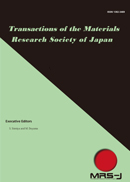Volume 42, Issue 6
Displaying 1-6 of 6 articles from this issue
- |<
- <
- 1
- >
- >|
Regular Papers
-
2017Volume 42Issue 6 Pages 145-149
Published: December 01, 2017
Released on J-STAGE: December 01, 2017
Download PDF (528K) -
2017Volume 42Issue 6 Pages 151-153
Published: December 01, 2017
Released on J-STAGE: December 01, 2017
Download PDF (785K) -
2017Volume 42Issue 6 Pages 155-157
Published: December 01, 2017
Released on J-STAGE: December 01, 2017
Download PDF (454K) -
2017Volume 42Issue 6 Pages 159-162
Published: December 01, 2017
Released on J-STAGE: December 01, 2017
Download PDF (1158K) -
2017Volume 42Issue 6 Pages 163-166
Published: December 01, 2017
Released on J-STAGE: December 01, 2017
Download PDF (444K) -
2017Volume 42Issue 6 Pages 167-171
Published: December 01, 2017
Released on J-STAGE: December 01, 2017
Download PDF (675K)
- |<
- <
- 1
- >
- >|
